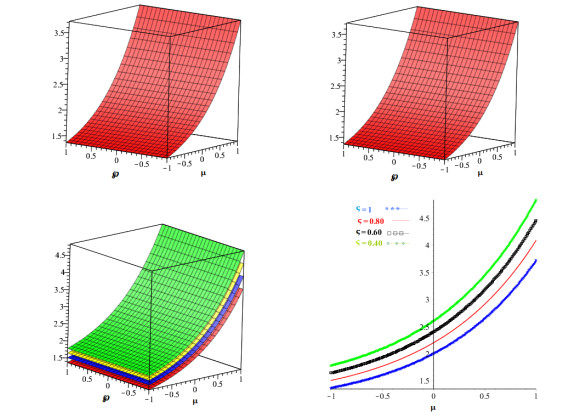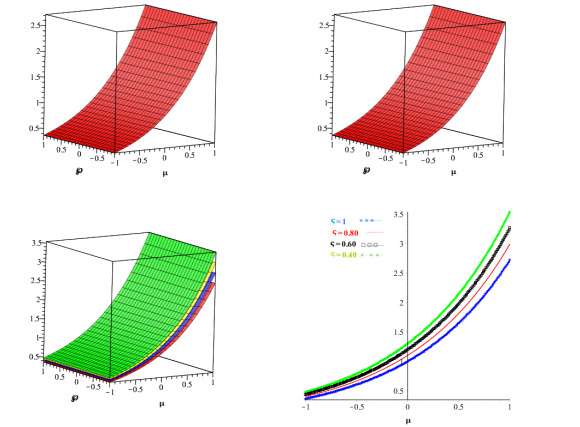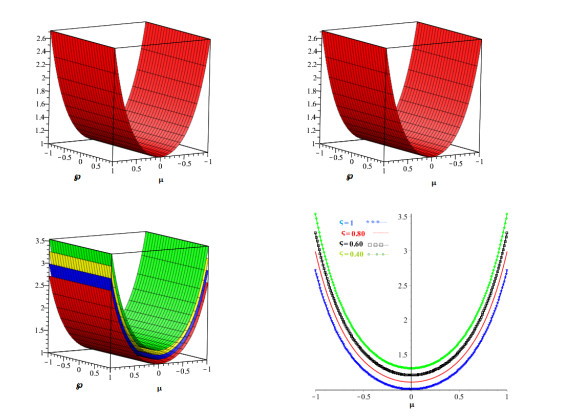1.
Introduction
Leibnitz developed a fraction in derivative, revealing that fractional calculus is better suited to modelling real-world problems than classical calculus. Fractional calculus theory provides an effective and systematic interpretation of nature's reality [1,2,3]. It has recently attracted interest because to its ability to provide accurate explanations for nonlinear complex systems. Fluid dynamics [4], electrodynamics [5], nanotechnology, finance, neurophysiology [6], and other fields have given fractional-order derivatives increasing attention. The concept of fractional calculus and its applications has developed fast in recent years [7,8,9,10]. Fractional calculus, which deals with arbitrary order derivatives and integrals [11], is important in many areas of applied science and engineering [12,13,14].
Because of its wide applications in the fields of physics and engineering, fractional differential equations have attracted a lot of attention in recent years [15]. Fractional differential equations accumulate the entire information of the function in a weighted form, as opposed to integer order differential equations, in which derivatives depend only on the local behaviour of the function. The memory effect [11,15] has numerous applications in physics, chemistry, and engineering. The solution of fractional order differential equations is a complex task. Due to their precise description of nonlinear phenomena, fractional differential equations have recently received a lot of interest. The broad applicability of these equations is the main reason for their popularity among mathematicians and physicists. Many mathematical models in mathematical biology, aerodynamics, rheology, diffusion, electrostatics, electrodynamics, control theory, fluid mechanics, analytical chemistry, and other fields have recently been successfully applied using nonlinear partial differential equations with fractional order derivatives.
It is essential to get correct or approximate solutions of nonlinear fractional partial differential equations in all of these scientific domains (NFPDEs). However, there is no approach that provides a precise solution for NFPDEs, and the majority of the solutions produced are simply approximations. In mathematical physics, engineering, and other sciences, the study of analytical or numerical solutions to NFDEs is essential. As a result, finding effective and appropriate solutions is essential. To solve NFPDEs, many analytical and numerical methods have been presented. Variational iteration approach [16], modified Adomian decomposition method (MADM) [17], differential transformation method (DTM) [18], optimal homotopy asymptotic method (OHAM) [19], and homotopy perturbation transform method (HPTM) [20] are the most widely used ones.
Numerous analytical techniques, like generalized Taylor fractional series method [21] and Finite difference method [22] have been implemented to solve CRDEs. Ali Khalouta used Aboodh variational iteration method to to find the exact solution of CRDEs [23]. Şuayip Toprakseven [24] used a weak Galerkin finite element method to solve CRDEs. Recently, Mounirah Areshi et al. the iterative transformation method and homotopy perturbation transform method to obtain the solution of CRDEs [25] and some other work are as [26,27]. In this paper we will suggest the Elzaki transform in combination with the CFD and ABC operators to solve three special CRDEs problems. We consider time-fractional convection-reaction-diffusion equation of the following
having initial source
and
having initial source
and
having initial source
In applied sciences, convection-reaction-diffusion problems are very helpful mathematical models. Equations of this type are used to model a variety of phenomena. The convection-reaction-diffusion equation, for example, is used to estimate river water quality by measuring the amount of organic matter contained [28]. Measurements of biologic oxygen demand on a section of the river are used to assess the location and intensity of pollution sources. An approach based on the minimization of a Kohn and Vogelius type cost function is used to tackle this inverse problem. In the case of air pollution, similar problems can be investigated [29]. Convection-reaction-diffusion equations have also been used to represent a variety of real-world processes, including heat conduction, chemical reaction-diffusion, and cancer tumour growth [30].
The following is a description of the paper's structure. We provide some necessary definitions and properties of fractional calculus theory in Section 2. The proposed method to solve CRDEs is introduced in Section 3 using a general methodology. Three examples are shown in Section 4 to demonstrate the efficiency and efficacy of the suggested approach. We present our results in the form of graphs and tables. The conclusion of this research is presented in Section 5.
2.
Preliminaries
Here we discuss the basic ideas of fractional calculus and Elzaki transform.
Definition 2.1. The fractional derivative in Caputo manner (CFD) is stated as [11]:
Definition 2.2. For a function ℓ(℘), the Riemann-Liouville integral of order fraction is stated as [31,32]
Definition 2.3. The fractional derivative in Atangana-Baleanu Caputo sense (ABC) is stated as [33]:
where ℓ∈H1(α,β),β>α,ς∈[0,1]. When ς=0 and ς=1 then normalisation function equal to 1 and is denoted by N(ς) as given in Eq (2.3).
Definition 2.4. The integral having fractional-order of ABC operator is stated as [33]
Definition 2.5. For exponential function, the Elzaki transform's is stated as in set A [34]
In the set, G is a finite number for a certain function, but p1, p2 may be finite or infinite.
Definition 2.6. The Elzaki transform is stated as [35,36]
where ℘≥0,p1≤ϖ≤p2.
Theorem 2.7. (Convolution theorem, [37]) The given equality holds:
where E{.} represents the Elzaki transform.
Definition 2.8. For the CFD operator C0Dς℘(ℓ(℘)), the Elzaki transform is stated as [38]
where m−1<ς<m.
Theorem 2.9. The Elzaki transform in terms of fractional ABC derivative ABCmDς℘(ℓ(℘)) is stated as
where E{ℓ(℘)}ϖ=˜U(ϖ).
Proof. As we know by Definition 2.3, thus:
Hence by the definition and and convolution of the Elzaki transform, we have
3.
General methodology
This section of the study will cover the most important technique used in this investigation. To explore this methodology, we utilise the fractional nonlinear PDE general form:
with initial source
and the boundary conditions
where known functions are ℓz,θ,γ0, and γ1. In Eq (3.1), the Caputo or ABC fractional derivatives are represented by Dς℘φ(μ,℘) while the linear and non linear terms are denoted by L(.) and N(.). We study E{φ(μ,℘)}(ϖ)=˜ζ(μ,ϖ) for Eq (3.1) by using CFD in Eq (2.8) and ABC in Eq (2.9) to perform the Elzaki transform. The fractional Caputo derivative's modified functions can then be obtained.
We also acquire the ABC derivative's modified functions, which are as follows:
where E[θ(μ,℘)]=˜θ(μ,ϖ). Now by taking the Elzaki transform of the boundary conditions, have.
The perturbation approach is then used to derive the solution to Eqs (3.1)–(3.3)
The nonlinear component in Eq (3.1) can be derived as
and the parts μE(μ,℘) are define as
We get the components of the Caputo operator's solution by substituting Eqs (3.7) and (3.8) into Eq (3.4),
We possess the recursive relation that results in the solution of the Atangana-Baleanu operator by sustituting Eqs (3.7) and (3.8) into Eq (3.5),
Thus, when Eqs (3.10) and (3.11) are solved with regard to X, the following Caputo homotopies are derived:
Furthermore, the ABC homotopies are determined as follows:
When X→1 is used, we can assume that Eqs (3.12) and (3.13) are the approximate solutions to Eqs (3.10) and (3.11), and that the solution is
By taking the inverse ET to Eq (3.14), we can estimate the solution of Eq (3.1).
4.
Applications
Example 1. In this part, we'll use the Elzaki transform to look at the problems in Eqs (1.1)–(1.6). To solve problem (1.1) with an initial source, we first use the Elzaki transform technique with the help of the Caputo derivative (1.2). We get by using the Elzaki transform.
To solve Eq (4.1), we employ the Elzaki perturbation transform method
By using the Elzaki inverse transform to Eq (4.2), we now have
In Eq (4.3), the μE(.) represents the nonlinear terms assumed in Eq (3.10),
The terms of the Caputo operator solution are then obtained by evaluating the related powers of X:
Thus, we get
which provides the problem's integer-order (ς=1) solution, φ(μ,℘)=1+e(μ+℘).
On the other side, we solve the problem using the Elzaki transform in connection with the Atangana-Baleanu operator. To begin, we solve the problem using the Elzaki transform:
To solve Eq (4.7), we employ the Elzaki perturbation transform method
By using the Elzaki inverse transform to Eq (4.8), we now have
Equation (4.9) contains μE(.) terms, which are nonlinear polynomials specified in Eq (3.9). By repeating the methods for nonlinear polynomials, we obtain:
Hence by means of ABC operator, the obtained solution is as follows:
which provides the problem's integer-order (ς=1) solution, φ(μ,℘)=1+e(μ+℘).
Example 2. Second, to address problem (1.3) with an initial source (1.4), we employ the Elzaki transform technique with the help of the Caputo derivative. We get the following results by applying the Elzaki transform:
To solve Eq (4.12), we employ the Elzaki perturbation transform method
By using the Elzaki inverse transform to Eq (4.13), we now have
In Eq (4.3), the μE(.) represents the nonlinear terms assumed in Eq (3.10),
The terms of the Caputo operator solution are then obtained by evaluating the related powers of X:
Thus, we get
which provides the problem's integer-order (ς=1) solution, φ(μ,℘)=e(μ+℘).
On the other side, we solve the problem using the Elzaki transform in connection with the Atangana-Baleanu operator. To begin, we solve the problem using the Elzaki transform:
To solve Eq (4.18), we employ the Elzaki perturbation transform method
By using the Elzaki inverse transform, we now have
Thus on comparing both sides
Hence by means of ABC operator, the obtained solution is as follows:
which provides the problem's integer-order (ς=1) solution, φ(μ,℘)=e(℘+μ).
Example 3. Finally, to address problem (1.5) with an initial source (1.6), we employ the Elzaki transform technique with the help of the Caputo and ABC derivative. To Eqs (1.5) and (1.6), we first employ the Elzaki transform along with the aid of Caputo derivative:
To solve Eq (4.23), we employ the Elzaki perturbation transform method
By using the Elzaki inverse transform to Eq (4.24), we now have
The terms of the Caputo operator solution are then obtained by evaluating the related powers of X:
Thus, we get
which provides the problems integer-order (ς=1) solution φ(μ,℘)=eμ2+℘.
On the other side, we solve the problem using the Elzaki transform in connection with the Atangana-Baleanu operator. To begin, we solve the problem using the Elzaki transform:
To solve Eq (4.28), we employ the Elzaki perturbation transform method
By using the Elzaki inverse transform, we now have
Thus on comparing both sides
Hence by means of ABC operator, the obtained solution is as follows:
which provides the problems integer-order (ς=1) solution, φ(μ,℘)=eμ2+℘.
5.
Results and discussion
The graphs of the exact and approximate solutions are depicted in Figure 1a and b, whereas the nature of the proposed method solution at various fractional-orders is shown in Figure 1c and d for problem 1. Figure 2a and b illustrate the nature of the exact and proposed method solution while Figure 2c and d demonstrates the behavior of the proposed technique at various fractional-orders. Similarly, Figure 3a and b gives the proposed method comparison with the exact solution and Figure 3c and d shows the layout of the suggested technique at different fractional-orders. In addition, we gives the error comparison in terms of two different fractional derivatives with the aid of various fractional derivatives for CRDEs in Tables 1–3. It is clearly observed from the figures and tables that the proposed method solution are in good agreement with the exact solution and converges quickly towards the exact solution. Also from the figures and tables we can conclude that proposed method solution converges towards exact solution as we tends from fractional-orders towards integer-order.
6.
Conclusions
The main concern of this work is to propose an efficient algorithm for the solution of nonlinear fractional convection-diffusion problems. The approximate solutions of some particular time-fractional convection-reaction-diffusion (CRD) equation are found in this paper using a new integral transform technique known as the Elzaki transformation. The proposed approaches are consisted of two steps. The given problems are first simplified using the Elzaki transform, and then the perturbation technique is employed to get the solutions. The proposed method is applied with the aid of two different fractional derivatives named Caputo fractional derivative (CFD) and Atangana-Baleanu fractional derivative (ABFD). The solutions of fractional order problems are investigated and fall into the best representation of the actual dynamics of the problems. To ensure the validity of the proposed method, we showed the results through graphs and tables. The suggested approach main benefit is the series form solution, which quickly converges to the exact solution. The current procedure is found to be very simple and an effective tool for the fractional partial differential equations and therefore can be extended to solve other problems in sciences.
Acknowledgements
The authors would like to thank the Deanship of Scientific Research at Umm Al-Qura University for supporting this work (grant code: 22UQU4310396DSR20).
Conflict of interest
The authors declare that there is no conflict of interest.










 DownLoad:
DownLoad:





